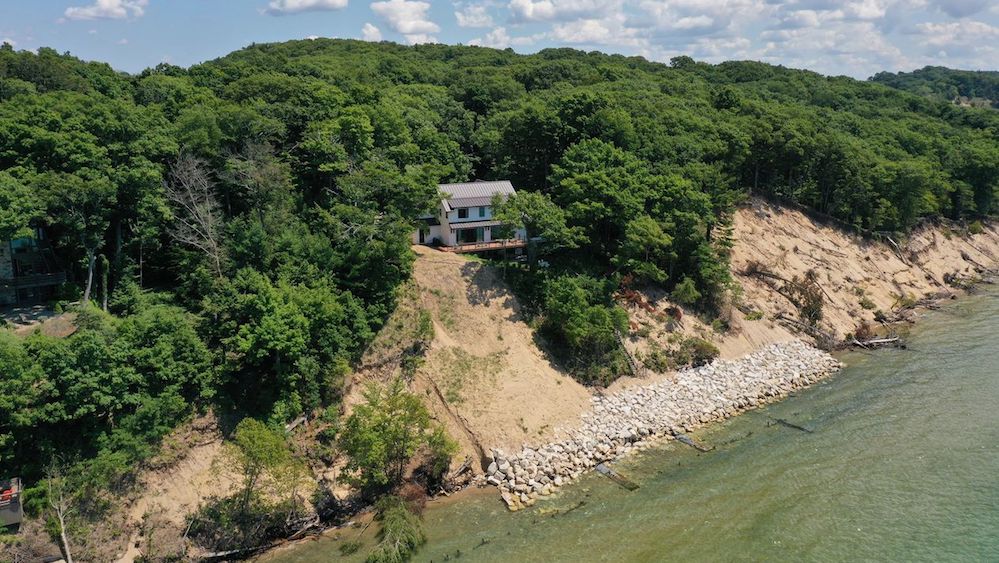
Brian McDonald for The Wall Street Journal
Paige and Darren Riopelle moved into their newly renovated Grand Haven, Mich., home in 2018, looking forward to roaming the beach of their property with their bulldog mix, Annie.
Two years later, feet and paws have yet to hit the sand.
As Lake Michigan’s water levels rose, 50 feet of their beachfront—half sandy beach and half dune grass—disappeared, and the deck with 75 stairs in front of their $2.5 million home collapsed. “Five feet past our current lawn is now a straight, vertical drop,” says Ms. Ripoelle, 49, an interior designer.
When they bought their home in 2016, the lake’s water levels were about 3 feet lower than today. They took their time doing some updates before moving in two years later.
Now, the two are working with an engineering firm to help salvage the bluff before their home slides down the dune, says Ms. Ripoelle. The revetment process is taking longer than planned due to Covid-19 shutdowns. The price tag: $500,000.
“We’re calling it our new liquid asset,” she says of the modern home.
BRIAN MCDONALD FOR THE WALL STREET JOURNAL
This summer, Lake Michigan’s water levels are on track to reach the highest on record since 1918, roughly 3 feet above their most recent low in 2013, according to data from the U.S. Army Corps of Engineers. That rise has left homeowners scrambling to protect their waterfront properties, while also dealing with fallout from a global pandemic.
Even homes that were set far back from the beach just a few years ago have lost entire beaches. The problem of having decks and staircases fall into the water is common nowadays, says Greg Weykamp, founder of waterfront engineering firm Edgewater Resources in St. Joseph, Mich.
“If the home is at-risk, it essentially has no value; nobody is going to buy that home, period,” he adds.
PHOTO: BRIAN MCDONALD FOR THE WALL STREET JOURNAL
Steve Sobkowiak, a developer from Downers Grove, Ill., says he spent nearly six months and hundreds of thousands of dollars to lengthen the steel barrier that offers protection from the storm waves crashing into his vacation property in Long Beach, Ind., one of many Lake Michigan beach towns popular with Chicagoans. The home is angled toward the lakefront and includes a rooftop bar, theater and outdoor living area with a fireplace. The process is scheduled to be completed this summer.
When he purchased the land in 2011, Mr. Sobkowiak was drawn to the area’s sandy beach and vacation feel. He added a barrier to protect against rising waters when he constructed the four-level, 4,200-square-foot home. But eight years later, it proved inadequate. Water was hitting the steel wall and he worried that waves would spill over the sides to damage the property or flood the street.
“It was a matter of time before we were next,” he says. “You could see it coming.”
Many homeowners were caught off-guard by the rising water levels of the past few years because Lake Michigan had a long period of low water from 2000 to 2013, says George Lucas, a Union Pier, Mich., real-estate agent. Then, just as many were ready to take action, the pandemic put things on hold, he adds.
Lake Michigan shoreline-protection projects typically cost between $200,000 and $300,000 per home and can take months to complete, says Mr. Weykamp who adds that costs typically aren’t covered by insurance. About a third of the homes he sees are in immediate risk of damage, with another third needing repairs within the next year, he says.
Not everyone wins the race against rising waters. After Joan and Bruce Smothers put their Stevensville, Mich., home on the market for $1.5 million in 2019, storms caused irreparable erosion to the bluff underneath the property.
The couple worried that their 2,500-square-foot house, a second home where they planned to retire, would end up in the water. After weighing their options, they decided not to take on the extra expense of relocating the home farther inland on the property.
BRIAN MCDONALD FOR THE WALL STREET JOURNAL
The post Rising Waters on Lake Michigan Are Threatening Luxury Homes appeared first on Real Estate News & Insights | realtor.com®.
source https://www.realtor.com/news/trends/rising-waters-on-lake-michigan-are-threatening-luxury-homes/
No comments:
Post a Comment